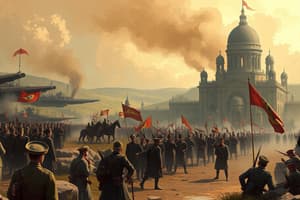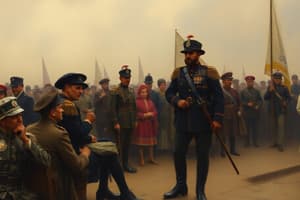Podcast
Questions and Answers
Who assassinated Archduke Franz Ferdinand?
Who assassinated Archduke Franz Ferdinand?
Gavrilo Princip
What position did Franz Ferdinand hold?
What position did Franz Ferdinand hold?
Heir to the Austria-Hungary throne.
Which country suffered the most casualties in World War I?
Which country suffered the most casualties in World War I?
Germany
What was the World Wide Flu epidemic?
What was the World Wide Flu epidemic?
What was the American policy when World War I broke out?
What was the American policy when World War I broke out?
Where was Franz Ferdinand assassinated?
Where was Franz Ferdinand assassinated?
Why did Great Britain enter World War I?
Why did Great Britain enter World War I?
What was the Schlieffen Plan?
What was the Schlieffen Plan?
What is a U-Boat?
What is a U-Boat?
What did the Zimmerman Note propose?
What did the Zimmerman Note propose?
What were the provisions of the Treaty of Versailles?
What were the provisions of the Treaty of Versailles?
What strategic disadvantage did Germany face at the outbreak of World War I?
What strategic disadvantage did Germany face at the outbreak of World War I?
What characterized trench warfare on the Western Front?
What characterized trench warfare on the Western Front?
What was trench warfare?
What was trench warfare?
Which front suffered the most casualties during World War I?
Which front suffered the most casualties during World War I?
Who was the President of the United States during World War I?
Who was the President of the United States during World War I?
What was the Lusitania?
What was the Lusitania?
When did the Paris Peace Conference take place?
When did the Paris Peace Conference take place?
Study Notes
Assassination of Archduke Franz Ferdinand
- Gavrilo Princip, a member of the Serbian terrorist group Black Hand, assassinated Archduke Franz Ferdinand in June 1914 in Sarajevo, Bosnia.
Background on Franz Ferdinand
- Franz Ferdinand was the heir to the Austro-Hungarian throne, visiting Sarajevo to inspect troops.
World War I Casualties
- Germany faced the highest casualties with approximately 2.2 million, followed by Russia (1.9 million), France (1.4 million), and Britain (900,000).
The Global Flu Epidemic
- A deadly influenza pandemic emerged, claiming over 20 million lives worldwide.
U.S. Initial Policy in World War I
- The United States initially maintained a policy of neutrality, but public opinion shifted to support the war effort after declaring war on Germany in April 1917.
Great Britain's Entry into World War I
- Great Britain entered the war in response to Germany's invasion of Belgium, which was guaranteed neutrality by Britain.
Schlieffen Plan
- Developed by General Alfred Schlieffen, this German military strategy aimed to prevent a two-front war between France and Russia.
U-Boat Warfare
- German submarines, known as U-Boats, were utilized to establish a blockade against allied powers during the war.
Zimmerman Note
- A secret communication proposing a German-Mexican alliance and promising support for Mexico in reclaiming territories; its discovery hastened U.S. entry into the war against Germany.
Treaty of Versailles
- Imposed on Germany in 1920, it required reparations, full responsibility for the war, disarmament, and the loss of overseas colonies and territories. Key provisions included:
- Stripping Germany of military capabilities.
- Mandating war reparations of $33 billion.
- Acknowledgment of guilt for causing WWI.
- Prohibition of weapon manufacturing.
Germany's Strategic Position at War Outset
- Germany faced geographical disadvantages with potential threats from both Western and Eastern fronts.
Trench Warfare on the Western Front
- Characterized by a deadlock in Northern France, the Western Front involved significant military operations and trench construction for protection.
Characteristics of Trench Warfare
- Trenches provided shelter against enemy fire, with notable weapons including:
- Infantry: rifles, shotguns, grenades, bayonets, flamethrowers.
- Machine Guns: key defensive tools used by both British and German forces.
- Tanks: introduced by the British, became essential despite initial ineffectiveness.
- Artillery: crucial for offensive operations.
- Chemical gases: such as mustard gas and chlorine.
Casualties on the Fronts
- Allies experienced approximately 6 million military casualties, while Central Powers lost about 4 million soldiers.
U.S. President During the War
- Woodrow Wilson served as President during World War I and later proposed the Fourteen Points to foster peace, influencing the creation of the League of Nations.
Lusitania Incident
- The British ocean liner Lusitania was attacked by a German U-Boat, resulting in the death of 128 Americans and contributing to U.S. involvement in the war.
Paris Peace Conference
- Convened in January 1919, the conference included the Big Three Allied leaders: Woodrow Wilson (U.S.), Georges Clemenceau (France), and David Lloyd George (Britain).
Studying That Suits You
Use AI to generate personalized quizzes and flashcards to suit your learning preferences.
Description
This quiz focuses on the key events and figures from World History Chapter 11, specifically the assassination of Archduke Franz Ferdinand. It covers important terms and definitions that are crucial to understanding the complex history surrounding World War I.




